Not Holding It In: ‘Urinetown’ Belmont High’s Number One Musical
Photo: Rehearsal for “Urinetown.”
For three days in April, the Belmont High School Performing Arts Company is turning the “Town of Homes” into “Urinetown.”
But don’t worry folks. Unlike the residents of the mythical city, it’ll still be free to pee for the steady stream attending this year’s spring musical. Rumors to the contrary are just yellow journalism.
With a big banner over Belmont Center and placards dotting yards announcing the show, the response from many curious residents upon seeing BHS PAC’s choice for the spring musical is:
- “Urinetown? What the … !”
- Yew!
But before you pass judgment, even the characters know that the show’s title and subject matter “could a kill a show pretty good!” as Little Sally tells the audience. Urinetown is, if anything, full of wit and humor about a subject that isn’t normal musical material.
Anyone who might be squeamish to buy a ticket due to the title, cast member Belmont High senior Jocelyn Cubstead said the show has universal appeal, for obvious reasons.
“If you know what it’s like to go to the bathroom really bad, this show is for you,” said Cubstead who portrays Penelope Pennywise, the strict matron of the filthiest urinal in the city.
While many might initially believe a musical about urinating is limited to a more mature audience, “‘Urinetown’ is anything but an ‘adults only’ event,” said Ezra Flam, the producer and director of this edition of the award-winning musical.
“People who aren’t familiar with ‘Urinetown’ and just hear the title or a brief description might not realize that this show is a musical comedy at heart, and the bizarre premise and dark plot are part of the humor and comedy,” said Flam, who has been rehearsing the students since December.
The musical is just as much about civil revolution and star-crossed lovers as it is the need to pay for “the privilege to pee.”
“Anyone from 4th grade and will get the show and appreciate the humor. Parents of kids younger than 4th grade might want to do a little more research before coming, but the title is definitely the most “un-PG” thing in the show,” said Flam, who noted the musical has “been a high school, college and community theater staple for the past decade.
And the plot is as contemporary as a billionaire trying to take control of the people only to have a courageous progressive standing in his way.
In a Depression-era metropolis, a 20-year drought has caused such a water shortage that the city government has banned private toilets. The citizens must use “public amenities,” regulated by a monopoly that profits by charging admission for one of humanity’s most basic needs.
Amid the people, a young, idealistic hero, Bobby Strong, decides he’s had enough and plans a revolution to lead them running to freedom! Along the way, the audience is kept informed of the plot with Officer Lockstock assisted by a street urchin named Little Sally. But, by the end, good intentions don’t always lead to the best outcome. But you’ll have to see the musical to find out what happens.
The plot moves along with a raw, jazzy Kurt Weill-inspired score (think of Urinetown as the “Spend a Penny Opera”) and lyrics that could have come from 1930’s progressive musicals such as “The Cradle Will Rock” only that the characters are not just freeing the masses but also their bladders.
The show was a hit on Broadway with Hunter Foster in the lead with Broadway legend John Cullum in the role of the ‘evil’ Caldwell B. Cladwell. The musical won Tony Awards for the script, score and direction in 2001.
“It opened on Broadway just after 9/11, (it was originally scheduled to open on Sept. 13 but was pushed back a week) which was a tough time for theater in New York, so that’s a big reason people haven’t heard of it,” said Flam.
But once the word filters out, Belmont will be ready to stand in line for the privilege to see “Urinetown.”
Performances are:
- Thursday and Friday, April 7 and 8, at 7 p.m.
- Saturday, April 9 at 1:30 p.m. and 7 p.m.
Tickets will be online and at Champions Sporting Goods in Belmont Center. Tickets are $10 for students (BHS students get half price tickets Thursday) and $15 for adults ($18 if they wait to buy them at the show).

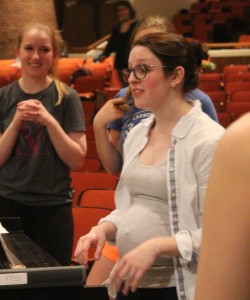
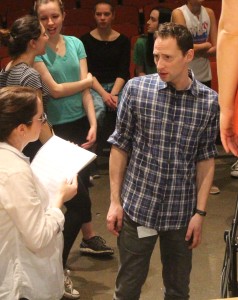



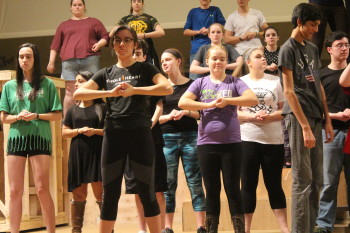
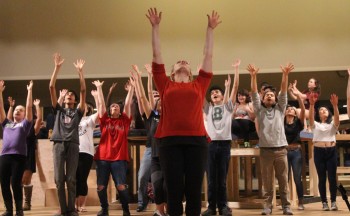
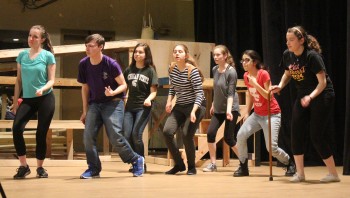
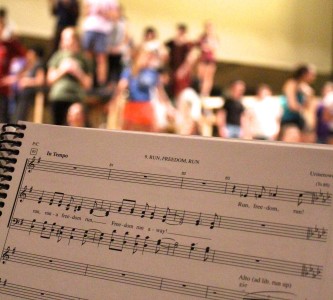



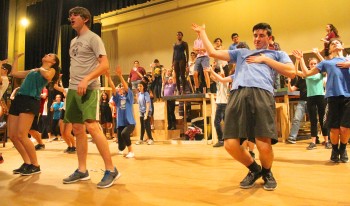


The Stand-Up Campaign Comes To Belmont Tuesday
Photo: Logo.
The Stand-up Campaign, a new initiative based in Belmont, will hold a listening and information sharing meeting, “Kindness, Decency and Civil Discourse” on Tuesday, March 29 at 7 p.m. at the First Church Belmont, Unitarian Universalist Church, 404 Concord Ave.
This will be the first in a series of events to explore strategies to promote kindness, decency, civil discourse and civic engagement in schools, sports and the larger community.
Adults, teens, educators and school officials, town administrators and elected officials, coaches and sports administrators, public health and safety officers from Belmont and surrounding communities are encouraged to attend and to share their concerns, experiences and best practices, as well as suggestions for future programming.
The Stand-up Campaign was formed to address the uptick in targeted taunting and bullying in area schools and sporting events in recent months and to promote civil discourse between individuals and parties with opposing views.
The Stand-up Campaign has partnered with Belmont Against Racism and the Unitarian Universalist Social Action Committee for this event. For more information, contact Donna Ruvolo at 617-489-5446.
Gone in a Flash at Belmont’s Annual Egg Hunt
Photo: Out of the way!
A field covered with several hundred candy-filled plastic eggs. A few hundred children anticipating the hunt. You know the rest.
On the day before Easter, kids and parents descended on the Chenery Middle School playground for the 16th annual Belmont Egg Hunt, sponsored by the Belmont Savings Bank.
At 10 a.m., like a scene out of a junior version of “The Hunger Games,” the hoard of kid humanity enveloped the playground with one aim in mind: get eggs. For some, it was a chance to romp and scream as they collected the plastic shells; others had an all-business look in their eyes.
Within five minutes, the children had stripped bare the land of all but a few broken plastic containers. The 10 egg limit was not strictly followed by the tributes as the end result was to get as much as they could throw into their bags.
Over at the toddler section – at the playground equipment – the “action” was a bit less competative with some of the participants picking up an egg, putting it back down and then happily going off to find another.
The yearly hunt is geared towards being a family friendly event, said Susan Condrick of Gibson Sothebys International Realty, who along with her good friend, Carolyn Boyle of Hammond Real Estate, has been organizing the activity for the past few years.
Condrick praised Belmont Savings for “coming through each year” as the lead sponsor and for providing 200 “gold coins” that were included in the eggs. Pediatric Dental Arts of Watertown and the Toy Shop of Belmont provided gift certificates for bikes that were given to a child and toddler.
“This is really a community event for us, getting the volunteers together and coordinating the entire event. With middle and high school students helping, it takes 80 man-hours to put all the eggs together,” said Condrick.
“It’s a really fun event. Most kids are just excited to get two pieces of candy instead of one in an egg,” she said.

















Sold in Belmont: Big is So Passé, Small Is The Way to Go
Photo: Small and livable on the Elm.
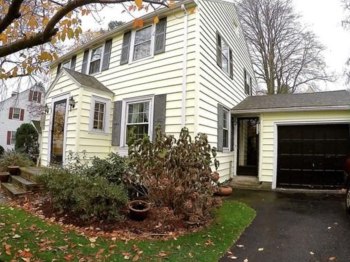
17 Little Pond Rd., Colonial (1947). Sold: $750,000.

54 Elm St., Brick Colonial condo (1928). Sold: $549,000.
A weekly recap of residential properties sold in the past seven-plus days in the “Town of Homes”:
• 17 Little Pond Rd., Colonial (1947). Sold: $750,000. Listed at $779,000. Living area: 1,542 sq.-ft. 7 rooms, 3 bedrooms, 1.5 baths. On the market: 123 days.
• 54 Elm St., Brick Colonial condo (1928). Sold: $549,000. Listed at $549,000. Living area: 1,162 sq.-ft. 6 rooms, 2 bedrooms, 1.5 baths. On the market: 62 days.
Today, many home buyers wouldn’t deem it worth their time to view a house that is smaller than 2,000 square feet. And as for new construction, 3,000 square feet appears the new minimum. Anything smaller is too “cozy” (translation: SMALL) for most modern families, the thinking goes.
But do you need a “great room” – remember when they were called living rooms? – with a kitchen the size of would equip a good-sized restaurant (so you can microwave dinner) in a floor plan in which you need roller skates to navigate the manse? Is it necessary to have five bedrooms when you only have two kids and relatives come by once a year and stay at the Meridian? A full size “play” space with the jacuzzi that no one uses? You’re a success of what you do, not what you own.
For a growing number of people, minimizing their footprint and their lives has become an important aspect of their lives. And there is a segment of the housing market to match these new demands. There is the extreme “tiny” home (300 square feet) phenomenon going on in the South and West – there aren’t any of these in Belmont … yet! – and the growing popularity of home designs and plans for homes with under 1,000 square feet, again outside of New England.
A pair of properties that sold this week in Belmont show why you would be wrong to think that big is better. The classic center-entry Colonial – just a bit over 1,500 square feet – on Little Pond shows what a little living care can go a long way to bring warmth and a modern feel to a fairly standard post-war design. The kitchen was upgraded with design smarts behind it, with new appliances and warm cherry color cabinets and Cambria countertop (Yes! anything but granite!). Space is not wasted here; you do most of your eating at the kitchen table adjacent where you cook (what a concept), and the bikes are parked beside the side door. The living room is a hop and step way and there is a dining room that is fine for most events; the stairway leads to three bedrooms and the full bathroom which was updated. Again, not a master suite in the boudoir but a bedroom that serves its function. Not a half acre out back for the coyotes to roam but a place for a grill and games.
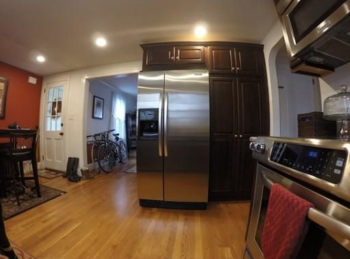





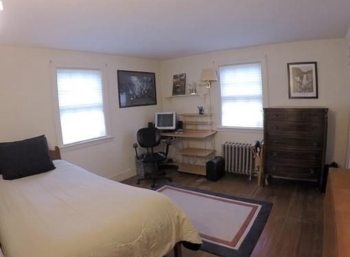

The condo on Elm is fascinating as it was a single family segmented into condos. I know something of this as my grandfather and his employer, a banker, “bought” – they foreclosed on an elderly man and threw him into the street in 1930 – a beautiful 1874 Colonial Revival with Victorian elements on Aldersey Street in Somerville. They literally split the house down the middle including dividing the grand staircase (!) and master bathroom.

The Tucker half of the house on Aldersey Street in Somerville.
But here, a magnificent brick and frame Colonial was converted into condominiums in 2010 with the space separated horizontally (thankfully!) with the first-floor space having 38 percent ownership and the second and third floor with 62 percent (with 1,900 square feet).
As a side note; what a great way to foster affordability to Belmont by taking those big homes and turning it into condos or apartments. Solidly built, they can be converted with a little care allowing buyers who can’t afford a seven-figure mortgage into Belmont.
Sure it’s 1,100 square feet, but the buyer is getting a condo with a sense of largeness, big rooms and lots of windows, which, if smartly used, you can create a loft feel which is pretty cool. The kitchen is spare but again, just a few upgrades and you can have a combo kitchen/dining area. Plus, no stairs and a big porch where you can spend summers getting a bit tipsy on wine coolers.
3,500 square feet? So passé! Go small.




Letter to the Editor: Common, Inclusive Solutions Needed In Belmont
Photo: Belmont Town Hall.
To the editor:
Good day, Belmont.
It is another town election cycle and this time, I am hearing some strange things that people believe is truth. Because I am on the campaign for Alexandra Ruban, I hope to share some of who I have learned Alexandra is.
Alexandra is a wife, mother and consultant who moved to Belmont for its great schools and active community. When she attended Town Day in 2013, she, like others, heard that part of the due diligence was that the town was seeking Request for Proposals from other trash and recycling vendors, having had the same vendor for 15 years without assessing the market. Three years later, we have not requested any bids, just bids like you would get if you were seeking a roofer, painter, driveway paver – and we have locked ourselves into another two-year contract with a 12 percent increase.
The reason I joined Alexandra in her bid for Selectman is because I, too, have been frustrated with policy and decision making in town: from global insights being used as a way to stall the adoption of solar energy, to really talented, committed experts in their fields being passed over for those who have successfully implemented moratoriums without any further policies and guidelines to help us when the moratorium lifts. There is unbelievable work happening in our town committees that takes herculean efforts (to gather data needed to be informed and make recommendations, years of complaints by few overshadowing the solutions presented that could accommodate all involved).
I gladly serve on the Economic Development Advisory Council under Tomi Olson, who has been a champion of mine as we bring forth proposals to help our home and business owners with real economic relief. Without a forward-thinking ally like Tomi, whether Alexandra has her vote or not, new, common-sense ideas would not be possible to consider at the Selectmen level. I, like Alexandra, am a business owner and present to and represent the highest level of senior executives often, yet I am afraid of how our Board of Selectmen will react to our proposal because I have experienced public and private backlash a few times already. Is this the way you want it to be?
Common, inclusive solutions, from establishing frameworks to allow us to preserve the tangible and intangible assets in Belmont are needed. Policy-making has to begin and end with an inclusive agenda to help our home and business owners thrive. For those who argue about the smallest number of transient residents who bring their families for a short period and leave, how about we figure out how to woo them to stay instead of blaming them, incorrectly, I may add, for taxing our public services.
Finally, become informed. That is the purpose of our campaign. Whether you have decided on one candidate or the other, get informed on what each of them has and can accomplish. And determine whose values, vision, and ability to make progress while preserving our town of homes match yours.
Erin Lubien
Unity Avenue
Three Belmont High Scouts Earn Their Eagle Wings
Photo: Belmont’s Eagle Scouts: Clay Moyles, Luke Peterson, Calvin Reinhardt-Ertman.
On Sunday, March 20, Belmont’s Troop 66 awarded Eagle Scout awards to three distinguished Belmont High School students: Clay Moyles, Calvin Reinhardt-Ertman and Luke Peterson.
As the highest rank in Scouting, the Eagle Badge requires notable discipline and sustained effort to achieve. It is estimated that fewer than seven percent of all Scouts attain this goal. Research indicates that those who do continue to distinguish themselves in later life through community volunteerism, charitable donations, environmental stewardship and professional leadership.
“Clay, Calvin and Luke are dedicated and accomplish Scouters who, through their Eagle Projects, have made a lasting impact on the town of Belmont. They personify the spirit of service and leadership that Scouting is all about,” said Scoutmaster Jesse Barnes.
Their combined Eagle Projects resulted in more than 500 hours of community service rendered by Scouts and other volunteers that have benefitted the Town of Belmont and its residents in multiple ways.
• Clay Moyles, a senior at Belmont High School, created a new logo for the Belmont Food Pantry, as well as a 24/7 drop-off container and signs to direct Belmont residents to the Pantry’s drop-off location.
A BHS Honors student, Clays plays the alto saxophone in the Wind Ensemble and played varsity Golf and Lacrosse. He was the recipient of Boston Globe Silver Key for Arts in 2012.
• Calvin Reinhardt-Ertman organized Scouts and other volunteers to re-landscape a portion of Belmont Town Hall’s grounds, planting them with winterberry, bearberry and other hardy native plants.
A junior at BHS, Calvin plays the violin in the orchestra. In summer 2015, he participated in the National Outdoor Leadership School, kayaking several canyons on the Green River in Utah and Colorado.
• Luke Peterson worked with the Belmont Department of Public Works to direct groups of Scouts in building three A-frame picnic tables that have been placed on Belmont parks to increase use and enjoyment.
Luke is an Honors and AP student at Belmont High School who has excelled in soccer and track and was a standout player for the Marauder’s varsity Basketball.
Clay, Calvin, and Luke participated in Troop 66’s 2014 High Adventure Trip to the Sierra Nevada Mountains in California. They hiked extensively in Kings Canyon National Park and summited Mount Whitney—which, at 14,505 feet, is the highest peak in the lower 48 States.
Letter to the Editor: Prestwich Professional Experience Value to School Committee
Photo: Andrea Prestwich
To the editor:
I met Andrea Prestwich and her husband Steve Saar ten years ago. Our kids have sung in the choir and attended Sunday School together, and more recently participated in Chenery Middle School’s extraordinary instrumental music program together. We have become good friends as our kids have aged from 2 to 12.
That’s why I was delighted when Andrea told me she was running for Belmont School Committee. She has a fascinating career in astronomy, and in her time at the Smithsonian Astrophysical Observatory Andrea has taken and active role in STEM education. She has been involved in science outreach, writing articles and giving presentations to the general public on all aspects of astronomy, making complex concepts understandable for people untrained in the discipline.
She was instrumental in starting a highly successful Research Experience for Undergraduates program at the Smithsonian-funded by the National Science Foundation. She has supervised graduate students and postdoctoral researchers, and for several years, she was director of the NASA Einstein Post-Doctoral Fellowship Program.
Andrea has a “top down” view of STEM education that would be very valuable on the School Committee. She has an analytical mind and professional experience that make her uniquely qualified to serve on curriculum and policy subcommittees. I urge you to vote for Andrea on April 5.
Kate Searle
Beech Street
Update: Waverley Commuter Rail Station Stays Open … For Now
Photo: The Waverley Station in Belmont.
Despite being out of the running for a portion of $150 million in state-financed accessibility upgrades, Belmont’s Waverley commuter rail station will remain open while the Massachusetts Bay Transportation Authority seeks a variance to delay required work on the site, according to an email message from State Sen. Will Brownsberger.
At a Friday, March 24 meeting with MBTA General Manager Frank DePaola about the future of the Waverley Station, Brownsberger said the Authority and the state’s Department of Transportation are conducting their capital planning process in which the DOT intends to allocate $150 million to upgrade the accessibility to its stations and other assets.
But while “[t]he specific project list has not been released … [DePaola] indicated that Waverley would not be on the list – other stations that are more heavily used are clear higher priorities for access improvements,” said Brownsberger.
While missing out on the current pool of funds to upgrade the facility in the heart of Waverley Square, Brownsberger said DePaola and the Authority would be “seeking a ‘time variance’ from the Architectural Access Board — keeping the accessibility upgrades of the station on the long-term to-do list, allowing the station to remain open and hoping to reach it as a project in the future.”
It was a decision by the state’s Architectural Access Board in 2013 that ordered the transportation authority to improve access to the Waverley Square commuter rail station to allow access-challenged citizens to take public transportation after what was considered “substantial” improvements were made to the station.
“If the AAB allows this variance, the station will remain open. Given the large investment that the MBTA is making in accessibility, it would be reasonable for the AAB to allow the variance,” said Brownsberger.
School Committee QW: Where Do You Stand on High Stakes Testing?
Andrea Prestwich
The MCAS has been to used fulfill the requirements of the Federal No Child Left Behind act (NCLB). NCLB was enacted with the best of intentions: to use rigorous standardized tests to ensure that all children receive a good education. Tests were used to track individual students progress, evaluate teachers and identify “failing” schools. The stakes were high: schools that did not make sufficient progress were closed, teachers fired, and students prevented from graduating.
Unfortunately, NCLB was a failure. Kids from wealthy families did better on the test than poor kids. Teachers were penalized for working with disadvantaged kids! To improve scores, teachers would focus on test preparation to the extent that other areas of the curriculum suffered. There were reports that struggling high school students were pressured into dropping out to make the average scores better. The tests are extremely stressful for students.
One of the few issues our hideously divided congress could agree on is that NCLB is a failure. Last year congress replaced NCLB with the Every Student Succeeds Act with overwhelming bipartisan support. The ESSA maintains the requirement for states to test, but gives states more freedom to define “school quality” and “accountability”. Given the new responsibilities under ESSA, I support the H340 requirement that the Commonwealth establish a task force to review the use of MCAS or PARCC data. Previous policies have failed, and it is time to re-evaulate what use we make of standardized tests. I also support the moratorium. Test results should not be used for teacher evaluation or student graduation while the task force does its job. To clarify: I fully support standardized testing. Standardized testing is crucial to identify problem areas and measure progress. However, we need to take a break and think about how test data is used in view of the failures of the past decade.
Murat Bicer
I am not generally in favor of standardized testing. Research shows that test results correlate above all to socio-economic conditions and may be unable to parse the quality of education at the individual or classroom level. Many tests are criticized for being biased and the system of test taking disadvantages students who have difficulties with structured, timed activities. I believe that multiple-choice tests are not a good indicator of how much a student has learned, or whether that student has the qualities that good students should have – like creativity, critical thinking, and curiosity. Any student who is struggling with basic skills should be identified and supported well before a test result points out his deficiencies. It is true, however, that Belmont has in the past used test results to identify areas of relatively weaker performance and make positive changes in those areas.
The Massachusetts Education Reform Laws of 1993 necessitate “a variety of assessment instruments” whose purpose is to evaluate student performance and to “improve the effectiveness of curriculum and instruction.” Tests have been credited with ensuring a certain quality standard across the state, but they’re imperfect. Unfortunately for all, many of the other “assessment instruments” such as descriptive reporting and subjective, essay-based testing are more difficult to administer and often put additional burden on the teachers, and that’s likely why testing has become the primary “instrument.”
We can probably all agree that accountability and adherence to a basic standard curriculum is necessary, but that needs to happen on a day to day basis within the school community, not as a result of, or in pursuit of, a test score.
Kimberly O’Mahoney
Personally, I have never been a big fan of standardized tests, but my only experience has been in the seat of a test-taker. I never felt that the tests provided the “bigger picture” of my educational experience and abilities. The testing also is narrowed to only include certain subjects, leaving behind the notion that a well-rounded educational experience (including extra-curricular areas) is most beneficial to the children. That being said, there are also benefits to the testing that is being administered. It does help support accountability and possibly identify those areas in the curriculum that may need review and reinforcement. Belmont, though, has always prided itself on the high quality of education that it affords the children in the District. With or without standardized tests, Belmont will keep this a priority. I don’t believe that the high standards that our educators are held to will diminish if this moratorium is put in place. It may allow for greater flexibility in instruction and allow classes to delve further into subject areas without the constraints of focusing on and preparing for the “test material.”
- «Previous Page
- 1
- …
- 243
- 244
- 245
- 246
- 247
- …
- 396
- Next Page»